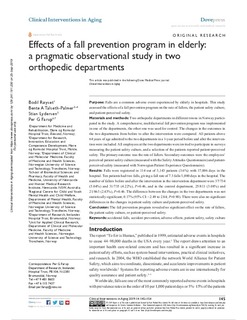| dc.contributor.author | Røyset, Bodil | |
| dc.contributor.author | Talseth-Palmer, Bente Anita | |
| dc.contributor.author | Lydersen, Stian | |
| dc.contributor.author | Farup, Per Grønaas | |
| dc.date.accessioned | 2019-09-25T06:42:31Z | |
| dc.date.available | 2019-09-25T06:42:31Z | |
| dc.date.created | 2019-04-10T20:10:42Z | |
| dc.date.issued | 2019 | |
| dc.identifier.citation | Clinical Interventions in Aging. 2019, 14 145-154. | nb_NO |
| dc.identifier.issn | 1176-9092 | |
| dc.identifier.uri | http://hdl.handle.net/11250/2618606 | |
| dc.description.abstract | Purpose: Falls are a common adverse event experienced by elderly in hospitals. This study assessed the effects of a fall prevention program on the rate of fallers, the patient safety culture, and patient-perceived safety.
Materials and methods: Two orthopedic departments in different towns in Norway participated in the study. A comprehensive, multifactorial fall prevention program was implemented in one of the departments, the other one was used for control. The changes in the outcomes in the two departments from before to after the intervention were compared. All patients above 64 years of age admitted to the two departments in a 1-year period before and after the intervention were included. All employees at the two departments were invited to participate in surveys measuring the patient safety culture, and a selection of the patients reported patient-perceived safety. The primary outcome was the rate of fallers. Secondary outcomes were the employees’ perceived patient safety culture (measured with the Safety Attitudes Questionnaire) and patient-perceived safety (measured with Norwegian Patient Experience Questionnaire).
Results: Falls were registered in 114 out of 3,143 patients (3.6%) with 17,006 days in the hospital. Ten patients had two falls, giving a fall rate of 7.3 falls/1,000 days in the hospital. The number of fallers before and after the intervention in the intervention department were 37/734 (5.04%) and 31/735 (4.22%), P=0.46, and in the control department, 25/811 (3.08%) and 21/863 (2.43%), P=0.46. The difference between the changes in the two departments was not statistically significant; 0.17% (95% CI: -2.49 to 2.84; P=0.90). There were also no significant differences in the changes in patient safety culture and patient-perceived safety.
Conclusion: The fall prevention program revealed no significant effect on the rate of fallers, the patient safety culture, or patient-perceived safety. | nb_NO |
| dc.language.iso | eng | nb_NO |
| dc.publisher | Dovepress | nb_NO |
| dc.rights | Navngivelse-Ikkekommersiell 4.0 Internasjonal | * |
| dc.rights.uri | http://creativecommons.org/licenses/by-nc/4.0/deed.no | * |
| dc.title | Effects of a fall prevention program in elderly: A pragmatic observational study in two orthopedic departments | nb_NO |
| dc.type | Journal article | nb_NO |
| dc.type | Peer reviewed | nb_NO |
| dc.description.version | publishedVersion | nb_NO |
| dc.source.pagenumber | 145-154 | nb_NO |
| dc.source.volume | 14 | nb_NO |
| dc.source.journal | Clinical Interventions in Aging | nb_NO |
| dc.identifier.doi | 10.2147/CIA.S191832 | |
| dc.identifier.cristin | 1691468 | |
| dc.description.localcode | This work is published and licensed by Dove Medical Press Limited. Open Access CC-BY-NC | nb_NO |
| cristin.unitcode | 194,65,15,0 | |
| cristin.unitcode | 194,65,35,5 | |
| cristin.unitname | Institutt for klinisk og molekylær medisin | |
| cristin.unitname | RKBU Midt-Norge - Regionalt kunnskapssenter for barn og unge - psykisk helse og barnevern | |
| cristin.ispublished | true | |
| cristin.fulltext | original | |
| cristin.qualitycode | 1 | |

